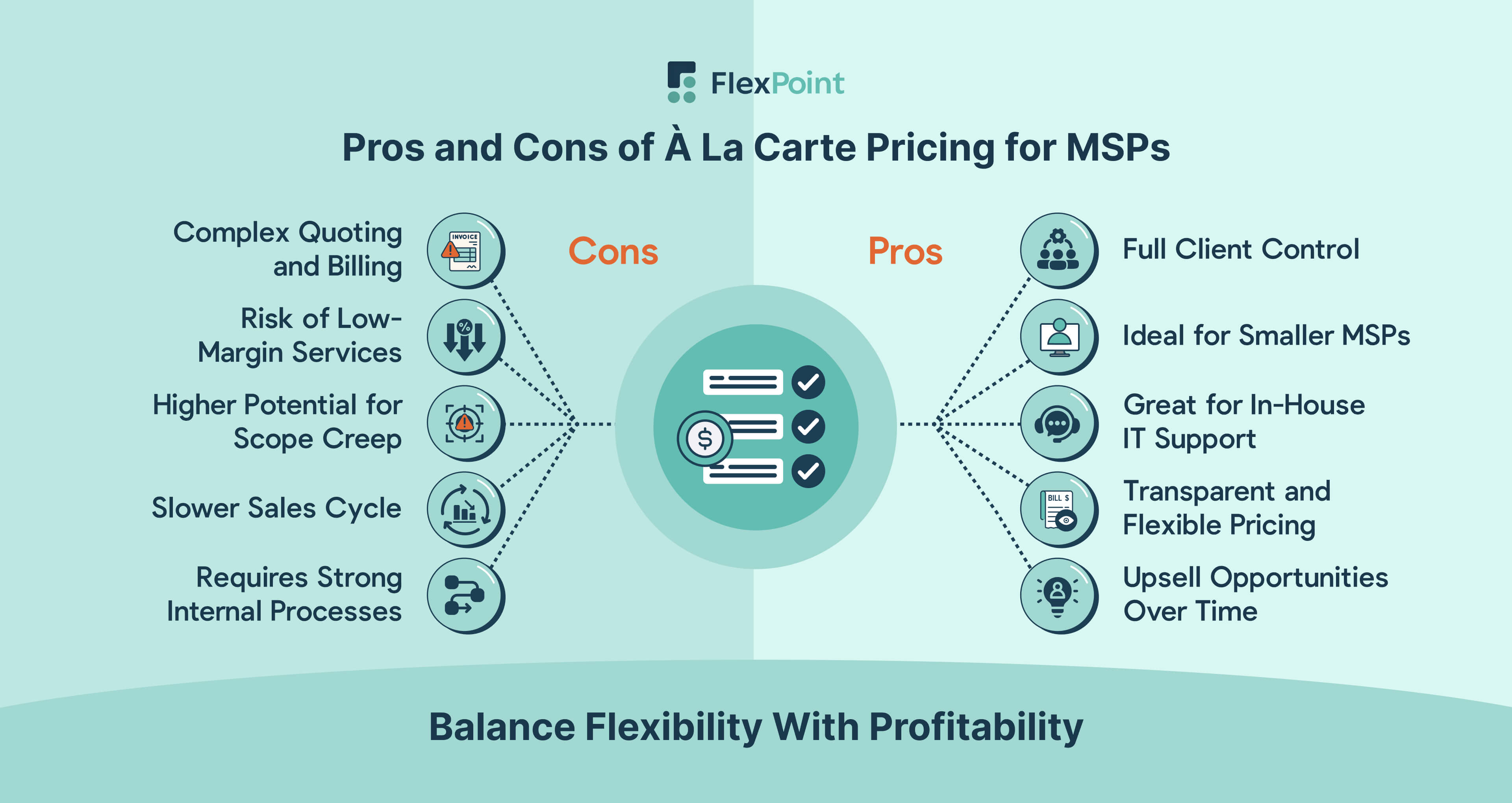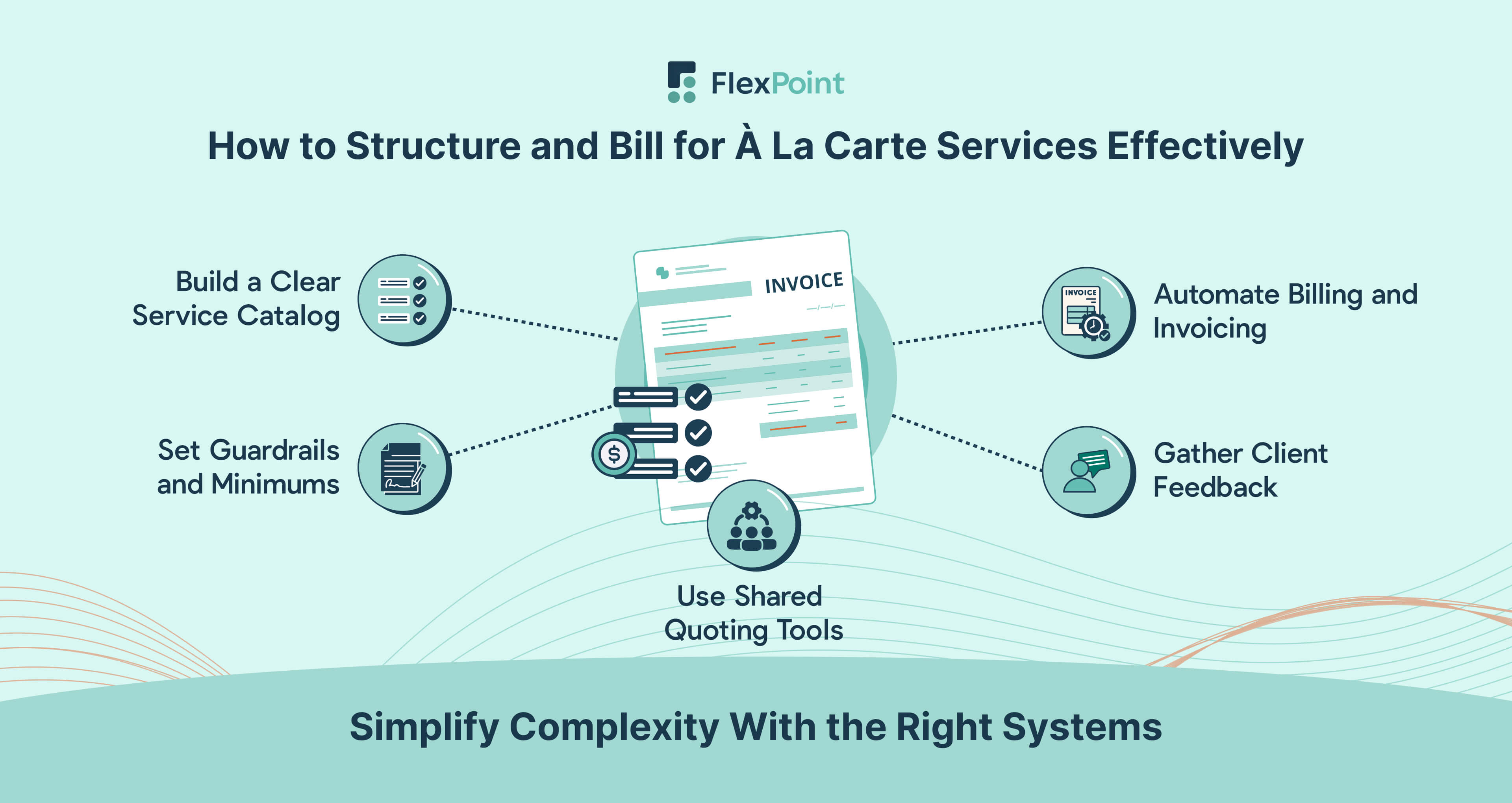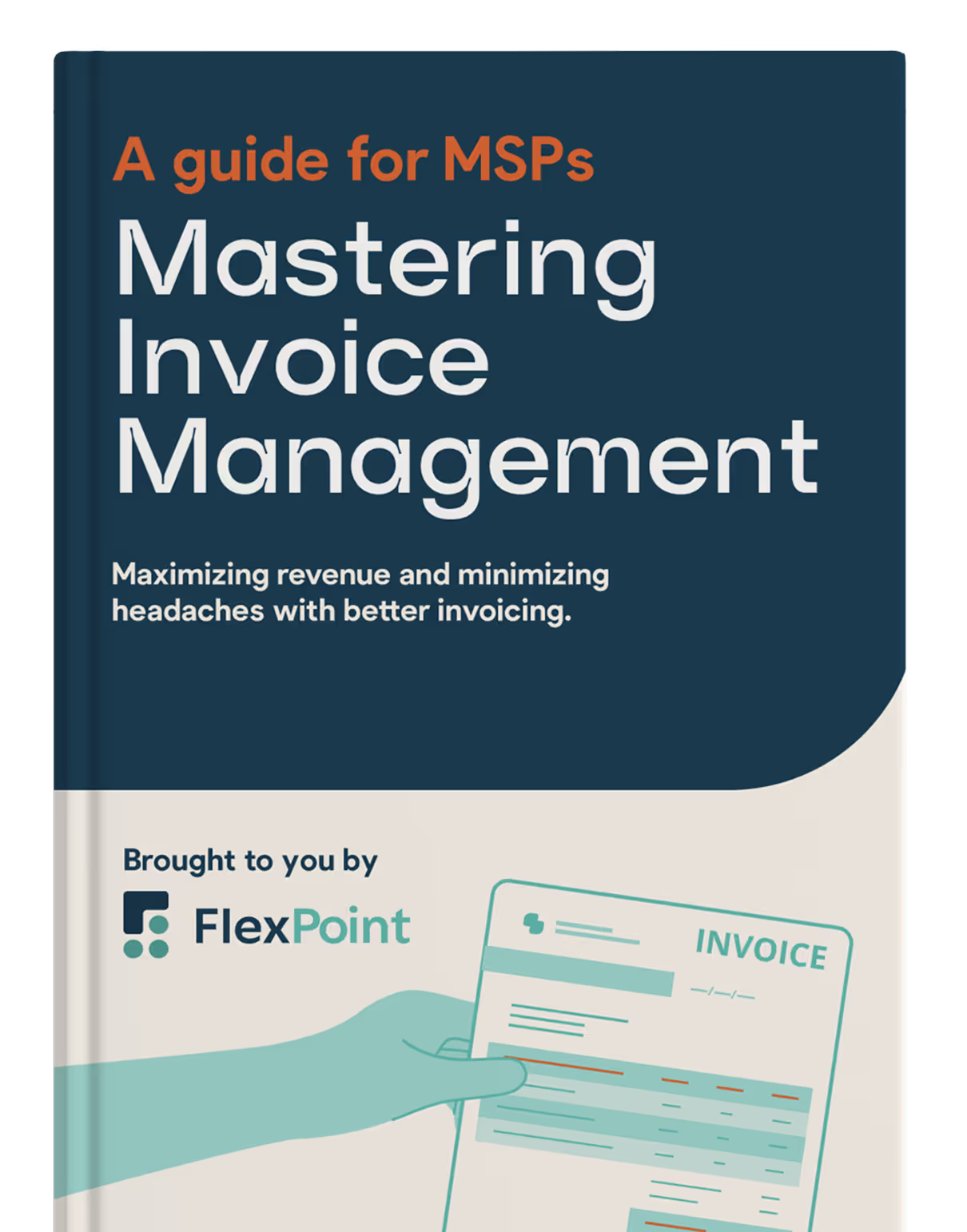MSP A La Carte Pricing: Flexibility or Complexity?

In an industry where service expectations are rising, à la carte pricing gives MSP clients the personalization they often demand—tailored plans that match their needs, budgets, and internal IT capabilities.
According to McKinsey & Company, 71% of consumers expect companies to deliver personalization, and 76% get frustrated when this doesn’t happen. À la carte pricing supports that expectation, giving MSP clients more control over their IT service mix and spending.
Instead of bundling all services into a fixed plan, this billing model lets clients select individual services, choosing only what they need. This approach appeals to businesses seeking flexibility, particularly those with internal IT teams or limited budgets.
However, for MSPs in particular, it poses certain challenges. When every client has a different setup, pricing, and billing can become disorganized. Without structure, profitability may suffer, and support can feel fragmented.
With that in mind, most opt for packages because they’re easier to sell, easier to bill, and help with recurring revenue. Still, some clients prefer a more tailored setup, especially when they only need one or two high-value services. À la carte options can open doors to new business if managed carefully.
In this article, we will explain how a-la-carte pricing works in the MSP space. We will examine the benefits and drawbacks, illustrate when it is well-suited, and provide clear strategies for implementation, particularly using an MSP-specific payment automation platform to help MSPs maintain accurate billing, protect margins, and adapt to client needs.
{{toc}}
What Is À La Carte Pricing for MSPs?
À la carte pricing allows MSP clients to choose services individually, rather than purchasing a pre-built bundle. Instead of offering a fixed package, the MSP lists services, such as backup, patching, or monitoring, and clients select only what they want.
This model contrasts with traditional flat-fee or tiered pricing, where services are grouped into levels, such as Bronze, Silver, or Gold. À la carte gives clients more say in what they’re paying for and removes anything unnecessary from the agreement.
For MSPs, this model requires clarity and transparency. Each service must have a defined scope, unit pricing, and delivery terms. The client should know exactly what’s included and what isn’t. Without that, confusion and disputes can follow.
A la carte pricing works best when clients have specific, limited needs. It can also be helpful when the MSP offers highly specialized services that don’t belong in every plan. However, it demands more administrative effort than a bundled approach.
This model can also help address the needs of clients who want transparency and control. When paired with service-level agreements and clear documentation, it becomes easier to manage expectations and avoid conflicts.
With the right systems, however, the complexity becomes manageable. Utilizing automated billing platforms that support custom combinations of services makes it easier to bill each client based on their specific selections, eliminating the need for manual tracking and reducing the likelihood of invoice errors.
{{ebook-cta}}
Pros and Cons of À La Carte Pricing For Managed Service Providers

A-la-carte pricing offers both advantages and limitations for Managed Service Providers (MSPs). On the surface, it’s a flexible model that helps you tailor services to individual clients and expand your market reach.
However, with that flexibility comes complexity, especially in quoting, billing, and ensuring long-term profitability.
From client benefits to operational trade-offs, understanding these pros and cons will help MSPs approach à la carte pricing with clarity and purpose.
The Pros of A La Carte Pricing:
- Clients get full control over what they buy: Instead of being locked into a bundle, clients choose exactly what they need. This gives them more flexibility and reduces wasteful spending.
- Better fit for smaller MSPs: Budget-conscious organizations or startups may not be ready for a full-service package. À la carte pricing allows them to start small while still receiving professional support.
- Ideal for MSPs with in-house IT: Companies that already have internal teams often just need a few add-on services. À la carte options let MSPs fill those gaps without duplicating work or overselling.
- Opportunity for long-term growth: Starting with a single service can lead to upsells over time. As the client’s needs expand, the MSP can offer additional services, strengthening the relationship and growing revenue.
À la carte pricing gives MSPs more flexibility in how they approach sales. You can meet prospects where they are, offer them a service or two, and grow the relationship over time. It also makes your pricing more transparent. Clients see what they’re paying for and can match costs to the value they receive.
This model enables more effective client targeting.
For example, a law firm may only need secure data backup and email archiving, while a retail chain might require endpoint protection and real-time monitoring. Being able to meet those distinct needs builds stronger client relationships.
The Cons of À La Carte Pricing:
- Quoting and contracts take more time: With each client requiring a custom configuration, sales teams must spend more time preparing quotes and reviewing agreements. This can slow down the sales cycle and increase overhead.
- Billing is more complex and prone to mistakes: Every client has a different set of services, which can lead to inconsistencies in invoicing. Without automation, errors are more likely and harder to catch.
- Profitability can suffer if clients only choose low-margin services: When clients cherry-pick cheaper options, it may result in a service plan that doesn't cover your costs or meet margin targets. This model requires careful planning to remain financially viable.
- Scope creep is more common when services aren’t clearly documented: Without precise definitions, clients may assume certain tasks are included. This puts pressure on support teams and leads to disputes if expectations are not aligned.
This pricing model requires strong internal processes. Without them, it’s too easy for mistakes to slip through, especially in billing. Service teams may also struggle to track which clients have access to which features. You may need to spend more time clarifying deliverables and boundaries.
Clients can also get overwhelmed. Too many choices might slow the buying process or lead to confusion. That’s why some MSPs add minimum commitments or create micro-bundles to simplify things.
Ultimately, à la carte pricing offers the most value when your internal tools can support complexity without draining resources. Automation and accurate documentation are critical.
When Does A-La-Carte Pricing Make Sense For An MSP?
This model works well when your client base is diverse. If you serve a mix of industries or company sizes, fixed bundles may not always apply. À la carte gives you room to adapt.
It’s also useful for:
- Clients with internal IT teams: These MSPs often manage day-to-day operations in-house but need outside support for specialized services. À la carte pricing lets them supplement their internal resources without paying for full coverage.
- Budget-conscious prospects: Smaller businesses or startups may not have the funds for bundled plans. Offering individual services allows them to access support where it matters most while staying within budget.
- Organizations with niche compliance or monitoring needs: Some clients operate in highly regulated industries or have specific oversight requirements. À la carte pricing helps tailor services to meet those demands without unnecessary add-ons.
It can also be effective in co-managed IT environments. In those cases, à la carte pricing allows clients to offload only the tasks they need help with, leaving internal staff in control of the rest.
This model may not be suitable for every MSP. It can be risky if you rely heavily on predictable, recurring revenue.
If your MSP team is small or prefers standardized delivery, the custom nature of à la carte pricing can hinder your progress. It also makes forecasting harder when every client’s spend is different.
Before making a decision, ask whether your current systems can support granular pricing. If you don’t have a billing solution that can handle service-based pricing, the model may become more of a burden than a benefit.
How to Structure and Bill for à la carte Services Effectively

Start with a clear service catalog. Each item should include pricing, delivery scope, and billing frequency. Use simple language to avoid confusion. A clear catalog serves as the foundation for all quoting and invoicing activities, ensuring that all stakeholders are aligned on what each service delivers.
Next, set guardrails. That might include minimum monthly charges or bundling two or three base services together. This ensures you aren’t onboarding unprofitable clients and helps maintain operational consistency. Guardrails also reduce the risk of misaligned expectations or underscoped engagements.
Sales and service teams should have shared tools to guide quoting. Prebuilt templates prevent inconsistencies. Clients should also receive proposals that list what is – and isn’t – included. This creates transparency and helps eliminate scope creep or billing surprises.
Billing is where à la carte models often fall apart. With every client on a different setup, manual invoicing becomes unsustainable. To succeed with this pricing model, your internal team must be trained on how to manage service combinations, pricing tiers, and exceptions.
Everyone involved (sales, billing, and support) should understand the service catalog and be able to communicate it clearly. Training also helps reduce friction during client onboarding and contract changes.
It also helps to build feedback loops into your process. Encourage clients to share what works and what doesn’t. This insight can guide service adjustments, pricing refinements, or bundled options that simplify future quoting. It also strengthens client relationships by showing that feedback leads to action.
With the right billing platform, you can offer flexible pricing without getting bogged down in administrative work. You reduce human error, speed up month-end processing, and give clients a better billing experience.
Ultimately, strong systems and thoughtful internal processes make it possible to scale a la carte pricing without sacrificing control.
Conclusion: Balancing Flexibility and Simplicity with À La Carte Pricing
A la carte pricing gives clients more choice and lets MSPs sell to a broader market. But it also brings more complexity. Without systems and structure, operations can be slowed, margins reduced, and billing challenges created.
When used thoughtfully, à la carte pricing becomes a tool to attract new clients, cater to specialized needs, or offer add-on services. Many MSPs find success by combining it with tiered plans or offering it as an option after a base commitment is met.
To make this model work long-term, you need clarity, consistency, and automation: define each service, track what’s sold, and automate as much as possible.
FlexPoint helps MSPs support à la carte pricing without manual effort. It aligns quotes, invoices, payments, and reports so you don’t lose track of what’s owed or what has been delivered. If you’re offering flexible service plans, it’s the platform that keeps everything organized.
FlexPoint also makes it easier to handle pricing adjustments, renewals, and service additions. Because everything is linked in one system, you avoid communication gaps and reduce friction across your financial operations.
In short, a-la-carte pricing can be an effective approach. But only if your systems work harder than your team.
Looking to offer à la carte services without billing complexity?
FlexPoint makes it easy to manage, bill, and collect payments for customizable service offerings.
Schedule a demo to see how FlexPoint supports flexible billing for modern MSPs.
{{demo-cta}}
Additional FAQs: MSP À La Carte Pricing
{{faq-section}}











